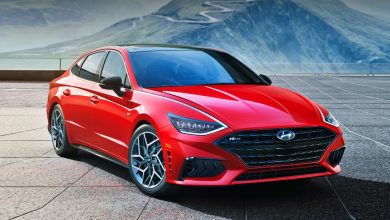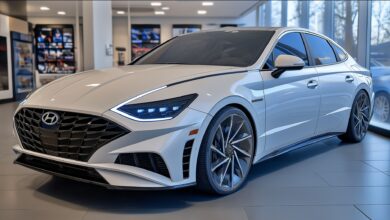2021 Hyundai Sonata Limited Price Review
2021 Hyundai Sonata Limited Price Review
2021 Hyundai Sonata Limited Price Review – The 2021 Hyundai Sonata arrives at the Middle sedan market starting at $24,330 for the basic SE class after the mandatory $930 purpose fee. Range-topping Limited applies to $34,230.
The cell class comes standard with a 2.5-liter four-cylinder making 191 horsepower (142 kilowatts) and an eight-speed automatic gearbox providing 32 miles per gallon of combined fuel economy. The standard features include Driver Safety Suite which has advanced collision-avoidance assist, continuously assisted pathways, follow assist paths, attention-warning driver, automatic high beam, and adaptive Cruise Control.
2021 Hyundai Sonata Limited Price Review

The convenience packs available for the $1,200 add useful features such as a 12.3-inch digital instrument cluster, wireless charging device, and an automatic dimming mirror. In addition to the comfort package, the $1,850 Premium package features a Bose 12-speaker stereo and heating, a leather-wrapped steering wheel.
The customer opened the ability to specify a $1,000 sunroof panorama that includes the top transparent and LED interior lights. Finally, the $950 Drive Guide system requires a premium package and a sunroof, but it gets the buyer’s 10.25-inch navigation system and driving highway help.
2021 Hyundai Sonata Limited Price Review
Upgrade to Trim CELL Plus for $28,380 add 1.6-liter with 180 HP (134 kW). The only options available are the $2,750 technology package which includes a panoramic sunroof, led interior lighting, 10.25-inch navigation screens, a 12-Bose stereo speaker, and a highway assist.
Limited classes come all the facilities available from other packages. I also added a matrix type of LED light. Inside, there is a ventilated front seat, memory for the driver’s seat and an outside mirror, a head-up display color, and a dashboard wrapped in leatherette. Additional safety features include front and rear parking sensors, an around-View monitor, remote parking assistance, a blind-spot view monitor, and rear parking collision avoidance.
When certain types of products become less popular, manufacturers who do not leave them at all sometimes hunger for their resources and accelerate their decline by focusing on the more popular types of products. Apply this reality to the automotive market today, and the less popular style is a mid-size sedan, where producers who have abandoned them or are in the process are Chrysler, Dodge, and Ford, and there will be more. As for sedan models that are starving resources, I’m not naming the model yet, but we have our eyes on some, and that’s inevitable.
Hyundai Sonata Limited Redesign
The redesigned driving day 2021 Hyundai Sonata proves a model that makes the name of the Hyundai in the US and beyond is not one of them. If any, the company has doubled down on the “Harness ” with a back to a slimmer style which is a major hit in the USA from 2011 to 2014 (but less so in the South Korean home market) before a 2015 redesign delivered the car Superior to what is considered Americans a conclude IOR look.
The new Sonata even heralds launch such an important feature as an option to use the smartphone as a key, the ability to move the car forward and back while standing outside of it, and brand Hyundai’s profile of the first and true driver Lane-centered steering features. How much Hyundai’s devotion to buyer Sonata will cost, however, remains unknown as a publication, because of the beginning (or maybe the final Hyundai).
Being Trim top, Limited has many exclusive features, including 360-degree camera system, blind-spot camera, matrix-style LED lamp, leather seat as standard, four-way seat passenger power, parking sensor, ventilated front seat, first Sonata Featuring head-up, faux leather (artificial Leather) dashboards and other features mentioned below.
2021 Hyundai Sonata Limited Interior

Hyundai Sonata Limited Features
The 2021 Sonata Limited drives well, especially on quality sidewalks around Montgomery, and the behaviors above some surprising examples of broken sidewalks I could find, as well as top rail tracks, pointed out that it would prove comfortable even in meaning The street from the hometown of Cars, Chicago, is it with AS-equipped 18-inch Alloy Wheels, 17S of CELLS or 16-inch alloys from a SE Sonata.
The car also handled competently, and while I wouldn’t say it was sporty, it seemed to give more than enough for potential buyers. This is a new platform, and the suspension design of Hyundai has come a long, far since the generation of people goes crazy about, so it’s not something I’m worried about as a shopper.
As for the power, I only experienced machines that came in CELL Plus and Limited, which assessed 180 horsepower and 195 pound-foot torque. It pushes the front wheels through an eight-speed automatic transmission. It has the simple power of the line but proves proficient to move the car forward gradually in a single motion without much downshifting.
Credit goes to torque availability; Torque, instantaneous power that gets a moving car, peaks from 1,500 to 4,500 rpm. With all the gears in the current play, sometimes lag and hunting can be an obstacle, and Hyundai is not immune to this, as we say from the opposite Top-Rated, 2019 Mid-size SUV Win-Winning 2019 Santa Fe Ultimate 2.0 T.
Read More: 2021 Hyundai Sonata N-Line USA Release Date
So, not having to Downshift as much is a plus. Fortunately, when it had to do so, the eight-speed was quite well behaved. Overall, electricity can be serviced but not outstanding, especially for the higher trim level. Surprisingly, despite the impressive torque, the engine is 180 HP lower than the base engine of 191 HP.
This horsepower is translated into speed, so the base machine may prove faster, especially since it pushes the light Trim level (specifications are not yet available, but fewer features mean less weight). The base torque machine is rated at 181 pounds-feet, but at a peak of 4,000 RPM than the area of Limited 1500-4500 RPM.
I do not lead to the size of the machine partially because we get to a place that does not matter as it used to be. The output specs are much more important. My engine drive was a fallacy version of the 1.6-liter four-cylinder turbocharged that was previously used at Trim Eco levels.
Hyundai Sonata Limited Engine
The base machine in SE and CELL are also new, now 2.5 liters Four cylinders (previously 2.4 liters). Both engines carry the name Smartstream and use regular gasoline. EPA hasn’t tested them yet, but Hyundai estimates a combined ranking of 33 MPG to 2.5-liter and 31 MPG to 1.6 liters. 33-MPG Figure will mark the 4-MPG improvement over the 2019 SE Sonata which is 2.4-liter.
If these machines seem strange close to each other in the output and strangely low when competitors offer more than 200 for 300 HP in their optional machine, you are not wrong. Missing is an optional 2.0 liter turbocharged 2019 four-cylinder that generates 245 HP. It will not come back, but an N-Line Sonata version is reported to be, at the specified time, carrying much more than 245 HP with it. The Hybrid Sonata is also scheduled to return but will be the final addition to the model 2020 years.
Hyundai has done a good job in driver assistance features such as forward-collision warnings with emergency braking and automatic pedestrian detection, a fixed track assist and adaptive cruise control with Stop-and-Go capability. Now have an umbrella term for them (like most competitors), SmartSense technology, along with new advancements to the Sonata.
We have long noted that the Hyundai (and its Genesis) Lane-keeping assist feature-as if a line of departure prevention systems, which is a competing vehicle may be the left and right car pinball between the lane sign the actual vehicle center in A better path than some competitors that have a feature called Lane-centered. Finally, Hyundai has a feature that it thinks is good enough to be classified as a path-centered, which has been named Lane Follow Assist. I want to say it’s even better, but I don’t see much difference on the gently curved path, because it’s been quite impressed with LKA-but I’m glad Hyundai is convenient.





